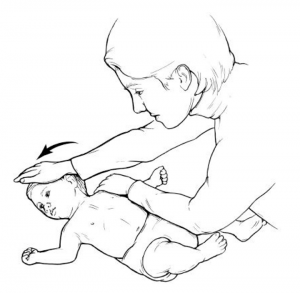Doctors’ Notes
BackInfant Torticollis Stretching Techniques
In last week’s Doctor’s Note, Dr. Karlovits shared her personal experience and provided lots of information about infant torticollis. In this follow-up Doctor’s Note, she explains and describes many stretching techniques and exercises to treat the condition…
Before we begin, please NOTE: The stretching techniques I describe here are all for RIGHT torticollis. You can modify them for LEFT torticollis simply by substituting LEFT for any RIGHT, and RIGHT for any LEFT in the instructions.
STRETCHING & POSITIONING FOR PLAY
Doing these stretching exercises, carrying your child properly, and correctly positioning the child for play can help to correct torticollis.
The best place for stretching exercises is a carpeted floor. Place your child on his back. If you’re sitting on the floor, you can place the child in your lap, with the child on his back and knees tucked.
SIDE BENDING [for RIGHT Torticollis]
Place your RIGHT hand on top of the RIGHT side of your child’s head. Hold your child’s RIGHT shoulder down with your LEFT hand. Slowly bend his LEFT ear towards his LEFT shoulder
Hold this position for 30 seconds, as tolerated by the baby. Repeat 2-4 times. Do this exercise 3-4 times a day.
ROTATION (HEAD TURNING) [for RIGHT Torticollis]
Place your LEFT hand on your child’s LEFT shoulder. Cup your child’s head with the RIGHT hand. Use your LEFT hand to hold your child’s chin
Slowly turn your child’s nose to his RIGHT shoulder.
Hold this position for 30 seconds. Repeat 2-4 times. Do this exercise 3-4 times a day.
POSITIONING FOR PLAY
Playing while lying on his side (side-lying): Position your child so he can play while lying on his side
This position allows gravity to do some of the work of stretching the neck and bringing the hands to the middle of the body. Bringing hands to the middle is an important step for feeding, hand-eye coordination, and other areas of your child’s development.
PLAYING ON HIS STOMACH
When your child is awake, it’s important he be placed on his tummy for play. This helps him learn to control his head movements.
When your child is on his tummy on the floor, place all toys so he has to turn his face to the RIGHT

You can help him turn his face to the left while he plays on his tummy.
CARRYING YOUR CHILD
Hold the child facing away from you, in a side-lying position, with your child’s RIGHT ear resting against your RIGHT forearm
Get your forearm between the child’s ear and shoulder to help stretch the tight muscles. You can use your forearm to lift your child’s head away from the shoulder to get a side-bending stretch. Place your LEFT arm between your child’s legs and support your child’s body and grasp her right shoulder with your left hand.
Carry your child in this position as much as possible. You can use this position to stretch the tight muscles if your child doesn’t tolerate the side-bending stretch well on her back.
OTHER SUGGESTIONS [for RIGHT Torticollis]
- Hold toys so that your child has to look up and out to his RIGHT.
- Position your child in the crib so activities in the room encourage her to look RIGHT.
- While breastfeeding or bottle-feeding your child, position him to face RIGHT.
- While holding your child across your shoulder, position her to face RIGHT.
- When not in the car, don’t use the car seat as a place to put your child for playtime.
- Your pediatrician or therapist can show you ways to use rolled-up baby blankets and towels to help keep your child’s head in a neutral position.
- If your child is ready and it is indicated, a physical therapist can show you how to encourage him to actively move his head to strengthen and stretch the neck muscles.
If your child doesn’t improve with these exercises, consult your Kids Plus Provider.
Dr. Ditte Karlovits joined Kids Plus in 2012.